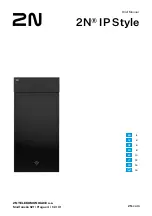
7
Art.3356, 3456 e 3556
Istruzioni di montaggio
Art.3356, 3456 e 3556
Mounting instructions
A
B
B
B
B
D
E
E
E
E
F
fig.4
G
H
C
fig.5
I
L
A
M
F
N
N
N
N
O
Piano terra finito
Finished Floor
Piastra di fissaggio Videocitofono
Mounting Plate
135cm
Quote in cm
Size in cm
fig.6
A
Mounting plate
installation and PCB
connections
Installing the Videophone onto mounting plate
!
!
!
!
!
!
!
!
Place the mounting plate
against the wall as
shown in
(135cm from floor level); and
mark the fixing holes for the four wall plugs
(
) and for the back box
if used (
)
which must be flushed into the wall in line with
the opening
as shown in
.
Once the back box
is flushed into the wall (if used), drill the four
fixing holes and insert the wall plugs
. Thread the cables through
the opening
and fix the mounting plate
to the wall with the 4
screws
(
), using a Philips screwdriver.
Fit the PCB
against the mounting plate
as shown in
; insert
the wires
(As short as possible) into terminals
. Secure them
using a terminal screwdriver.
Unclip the PCB
(
), rotate it 90º anticlockwise and fit it into its
housing as shown in
.
As shown in
, move the videophone
close to the mounting
plate
so that the ribbon cable will reach the connector .
As shown in
, connect the female plug on the ribbon cable I
coming from the videophone to the male plug connector
on the
PCB .
Place the videophone
against the 4 hooks
on the mounting plate
and push down: the videophone will automatically lock into place
using clasp
as shown in
.
To remove the videophone from the wall, push the clasp
in the
direction of the wall with a screwdriver and at the same time push the
videophone upwards.
We recommend using a back box in order to contain excess wire
behind the back plate.
The wires must be connected to the terminals as shown on the
relevant wiring diagrams.
A
fig.6
B
fig.4
C
fig.4
D
fig.4
C
B
D
A
E fig.4
F
A
fig.4
G-H
F fig.4
fig.5
fig.5
L
A
I
fig.5
M
F
L
N
A
O
fig.5
O
Notes
(1)
(2)
(1)
(2)
Applicazione a muro della piastra di
fissaggio e collegamenti scheda di
connessione
Applicazione del Videocitofono alla piastra
!
!
!
!
!
!
!
!
Appoggiare al muro la piastra di fissaggio
come indicato in
(135cm da terra);
prendere i riferimenti dei quattro fori per
l’inserimento dei 4 tasselli ad espansione
(
) e, nel caso si impieghi, prendere il
riferimento per la scatola da incasso
(
), che dovrà essere
murata in posizione centrale rispetto all’apertura
al fine di
agevolare il passaggio dei fili come mostrato in
.
Murare (se impiegata) la scatola da incasso
, eseguire i 4 fori ed
inserire i tasselli ad espansione
. Passare i cavi nell’apertura
e
fissare la piastra
con le 4 viti
(
) utilizzando un cacciavite a
croce.
Appoggiare la scheda di connessione
sulla piastra
come
mostrato in
; inserire
i fili (che devono essere più corti
possibile) nelle morsettiere
ed
e serrare con un cacciavite a
taglio.
Fissati i fili, sfilare la scheda di connessione
(
), ruotarla di 90º
in senso antiorario ed infilarla nella propria sede come mostrato i n
.
Avvicinare, come da
, il videocitofono
alla piastra
per
agevolare la connessione del flat .
Come mostrato in
inserire il connettore del flat , che fuoriesce
dalla parte posteriore del videocitofono, nel connettore
della
scheda di connessione .
Facendo corrispondere le 4 fessure presenti sulla base del
videocitofono
con i 4 incastri
della piastra , appoggiare il video
sulla piastra e spingerlo verso il basso fino allo scatto, compiendo
un movimento come mostrato dalle frecce in
.
Per rimuovere il videocitofono, spingere con un cacciavite a taglio il
dente
verso il muro e, contemporaneamente, tirare il videocito-
fono verso l’alto.
Si consiglia di utilizzare una scatola da incasso (non in dotazione) al
fine di contenere l’eventuale lunghezza eccedente dei fili.
I collegamenti alla morsettiera devono essere eseguiti rispettando
gli schemi forniti a corredo del videocitofono, per applicazioni
differenti da quelle degli schemi standard, rivolgersi al proprio
rivenditore.
A
fig.6
B
fig.4
C fig.4
D
fig.4
C
B
D
A
E fig.4
F
A
fig.4
G
H
F fig.4
fig.5
fig.5
L
A
I
fig.5
I
M
F
L
N
A
fig.5
O
Note
(1)
(2)
(1)
(2)






































